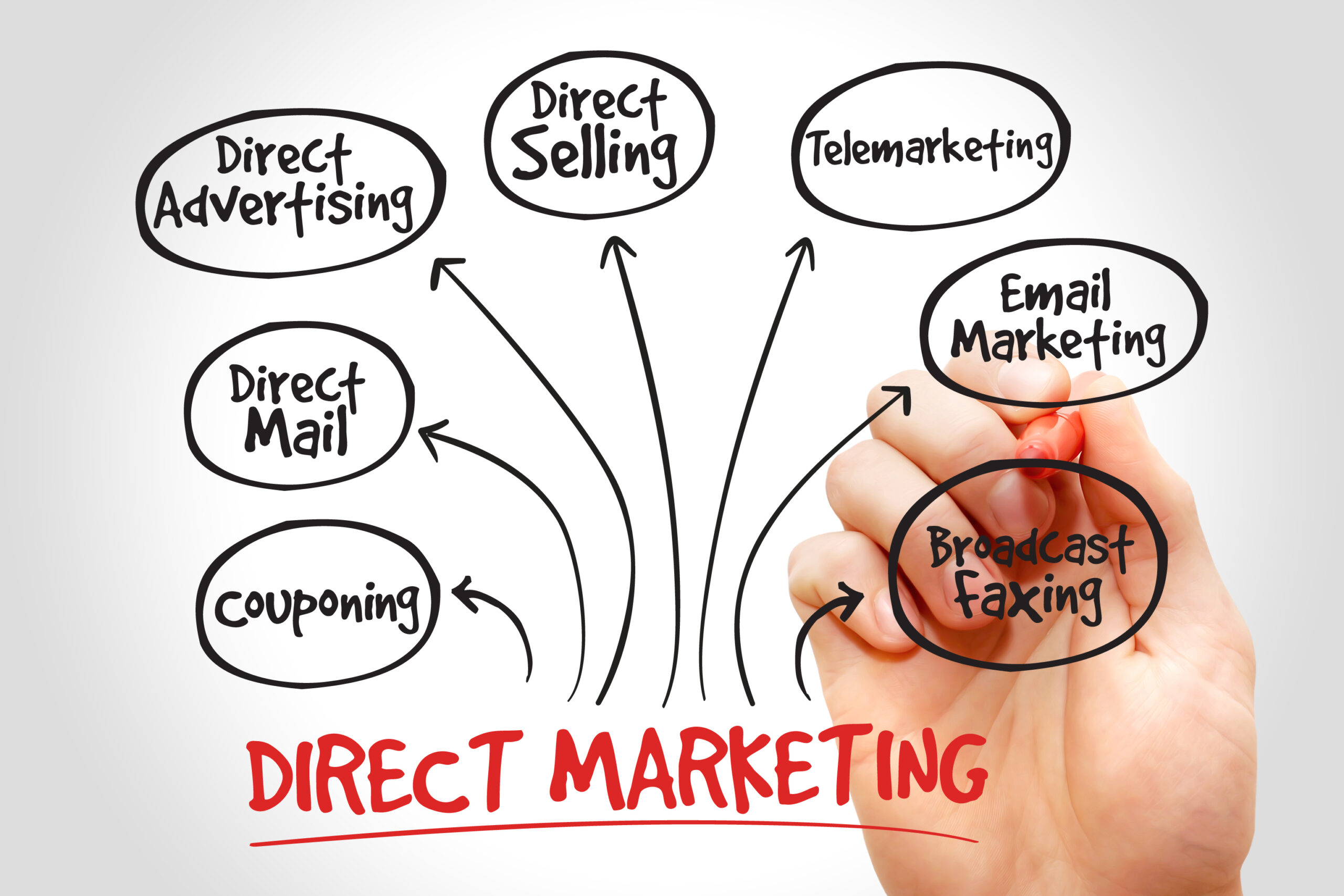In an industry overflowing with advertisements and generic promotions, cutting through the noise and reaching your audience with a message that truly resonates is no small feat. This is where direct marketing shines. Unlike broad campaigns that cast a wide net, direct marketing focuses on personalized, one-on-one communication that speaks directly to your clients’ needs, preferences, and desires.
This blog will explore the types of direct marketing that businesses can leverage to drive engagement, build trust, and achieve measurable success. Whether you’re looking to generate leads, boost sales, or enhance customer loyalty, these strategies will provide the blueprint for crafting campaigns that deliver results. Let’s dive in!
What Is Direct Marketing?
Direct marketing is a highly targeted and personalized marketing approach that focuses on communicating directly with potential customers, bypassing intermediaries such as retailers or mass media platforms. The goal of direct marketing is to elicit a specific action from the audience—whether it’s making a purchase, signing up for a service, or engaging with a promotional offer—through customized and measurable communication strategies.
Unlike traditional advertising, which targets broad audiences, direct marketing delivers tailored messages to specific segments of the market. This precision allows businesses to address individual customer needs, preferences, and behaviors, making the messaging more relevant and impactful.
The Core Types of Direct Marketing
Direct marketing offers businesses a range of methods to engage with clients in a personalized and impactful manner. Each type of direct marketing caters to different customer preferences and business objectives, ensuring flexibility and relevance. Here are the core types of direct marketing and their unique benefits:
1. Email Marketing
Email marketing is one of the most widely used and effective forms of direct marketing. It enables businesses to deliver personalized messages to their audience’s inbox, promoting products, services, or events.
Key Benefits:
- Allows for segmentation and tailored content based on customer preferences.
- Cost-effective for both small and large-scale campaigns.
- Easily measurable with metrics like open rates and click-through rates.
Best Practices:
- Use engaging subject lines to grab attention.
- Personalize content to address individual customer needs.
- Include a clear call-to-action (CTA) to drive engagement.
2. Direct Mail Marketing
Direct mail involves sending physical promotional materials like brochures, postcards, or catalogs to customers’ mailboxes. This traditional yet effective method creates a tangible connection with the recipient.
Key Benefits:
- Stands out in a digital-first world by offering a personal touch.
- Highly targeted, ideal for reaching local or niche audiences.
- Provides an opportunity for creative, visually appealing designs.
Best Practices:
- Design eye-catching materials with concise messaging.
- Include personalized elements, such as the recipient’s name or location.
- Track responses through QR codes, promo codes, or personalized URLs.
3. Telemarketing
Telemarketing involves making direct phone calls to potential or existing customers. This method is particularly effective for building relationships, answering questions, and closing sales.
Key Benefits:
- Provides real-time interaction, allowing businesses to address customer concerns immediately.
- Builds trust through one-on-one communication.
- Effective for high-value or complex product and service offerings.
Best Practices:
- Use skilled representatives who can handle objections and maintain engaging conversations.
- Respect customer preferences, such as time zones and call times.
- Utilize scripts as guidelines while keeping interactions natural and authentic.
4. SMS Marketing
SMS marketing delivers concise and actionable messages directly to customers’ mobile phones. It’s ideal for time-sensitive promotions, reminders, or updates.
Key Benefits:
- High open rates, often exceeding 90%.
- Quick delivery, ensuring timely engagement.
- Works well for short-term offers or event notifications.
Best Practices:
- Keep messages brief and to the point.
- Include clear instructions for opting out to maintain compliance.
- Integrate SMS with other marketing channels for a cohesive approach.
5. Face-to-Face Marketing
Face-to-face marketing, often executed through events, trade shows, or in-person promotions, focuses on building personal connections with customers.
Key Benefits:
- Creates lasting impressions through direct, human interaction.
- Allows for immediate feedback and personalized recommendations.
- Effective for showcasing products and services in real time.
Best Practices:
- Train staff to align messaging with brand values.
- Provide promotional materials or samples to leave a tangible impact.
- Follow up after in-person interactions to nurture relationships.
Each of these direct marketing types offers unique opportunities for businesses to engage customers and drive measurable results. By selecting the right method—or a combination of methods—businesses can craft campaigns that resonate with their target audience and achieve their objectives.
Enhancing Direct Marketing Success
1. Leveraging Customer Loyalty Programs in Direct Marketing
Customer loyalty programs are an excellent extension of direct marketing efforts. These programs encourage repeat purchases and long-term engagement by rewarding customers for their loyalty.
Implementation Tips:
- Offer points for purchases that can be redeemed for discounts or exclusive products.
- Use direct mail or email to inform customers about loyalty rewards.
- Create exclusive offers for loyalty members to enhance retention.
2. Combining Direct Marketing with Referral Programs
Referral programs allow businesses to expand their reach through word-of-mouth marketing while keeping the focus on direct customer engagement. By incentivizing existing customers to bring in new clients, businesses can create a cycle of engagement and growth.
Implementation Tips:
- Send referral program details via email or SMS for easy access.
- Offer rewards such as discounts, free products, or gift cards to both referrers and referees.
- Use direct mail to send referral program brochures or flyers.
Creating Client-Focused Marketing Campaigns
A successful direct marketing campaign goes beyond simply delivering a message; it prioritizes the needs, preferences, and behaviors of the target audience. Client-focused marketing ensures every interaction resonates with the customer, creating personalized experiences that drive engagement and inspire action. Here’s how to design and implement campaigns that truly put the client first:
1. Understand Your Audience
The foundation of any client-focused campaign is a deep understanding of your audience. Gather data through surveys, customer feedback, purchase history, and behavior analytics to identify their needs and preferences.
Tips to Implement:
- Segment your audience by demographics, location, purchase behavior, or interests.
- Identify pain points and tailor your messaging to address them directly.
- Use insights from past campaigns to refine your approach.
2. Prioritize Personalization
Generic messaging no longer resonates in today’s competitive landscape. Personalization makes customers feel valued, increasing the likelihood of engagement.
Examples of Personalization:
- Including the recipient’s name in emails or direct mail.
- Offering recommendations based on previous purchases or interactions.
- Sending tailored promotions for specific customer segments.
3. Focus on Value
Ensure every message provides immediate and clear value to the customer. This could be in the form of discounts, exclusive offers, helpful content, or solutions to a problem they’re facing.
Best Practices:
- Clearly articulate the benefits of your product or service.
- Use concise and compelling language to capture attention.
- Highlight time-sensitive offers to create urgency.
4. Leverage Multi-Channel Integration
While direct marketing focuses on one-to-one communication, integrating multiple direct marketing channels ensures broader reach and reinforces your message.
Examples:
- Combine SMS with direct mail to follow up on promotions.
- Use telemarketing to provide a human touch after sending email campaigns.
- Integrate loyalty programs with personalized mail to reward repeat customers.
5. Test and Refine Campaigns
Client needs and preferences evolve, and your campaigns should, too. Continuously test different elements, gather feedback, and refine your strategies to maximize impact.
How to Test:
- Perform A/B testing on subject lines, CTAs, and offers.
- Use small-scale pilot campaigns to gauge response rates before scaling up.
- Collect data on customer engagement to identify areas for improvement.
6. Build Relationships, Not Just Sales
A client-focused campaign aims to establish lasting relationships, not just one-time transactions. Focus on fostering trust and loyalty by showing genuine care for your customers.
Ways to Build Relationships:
- Send follow-up messages to thank customers for their engagement or purchase.
- Use surveys to gather feedback and improve future interactions.
- Offer exclusive perks for long-term customers, such as early access to sales or special rewards.
By prioritizing the client at every stage of your campaign, you not only enhance the effectiveness of your direct marketing efforts but also build a loyal customer base that drives sustained growth.
Direct Marketing Examples in Action
To illustrate the power of direct marketing, consider these real-world applications:
- Exclusive Offers via Email
A fitness center sent personalized membership renewal emails with exclusive discounts, resulting in a 20% increase in renewals.
- Loyalty Rewards Through Direct Mail
A local bakery mailed loyalty coupons to regular customers, leading to a 30% boost in repeat visits.
- Flash Sales via SMS
A retail store used SMS marketing to announce a one-day flash sale, generating a 50% spike in foot traffic.
These direct marketing examples demonstrate the tangible results that businesses can achieve by targeting their messages effectively.
Overcoming Challenges in Direct Marketing
While direct marketing offers immense potential for personalized engagement and measurable results, it’s not without its challenges. From navigating regulatory landscapes to maintaining customer interest, businesses must proactively address these obstacles to maximize the effectiveness of their campaigns. Here’s how to overcome the most common challenges in direct marketing:
1. Navigating Data Privacy and Compliance Issues
Direct marketing often involves collecting and using customer data, which comes with strict regulatory requirements. Laws like General Data Protection Regulation (GDPR) and CAN-SPAM require businesses to handle customer information responsibly.
Solutions:
- Obtain explicit consent before collecting or using customer data.
- Provide clear opt-in and opt-out options for all communications.
- Regularly update your privacy policies to ensure compliance with evolving regulations.
2. Avoiding Oversaturation and Message Fatigue
Sending too many messages or repetitive content can overwhelm customers, leading to disengagement or negative perceptions of your brand.
Solutions:
- Set frequency caps to limit how often customers receive messages.
- Ensure each communication offers unique value to the recipient.
- Regularly update content to keep campaigns fresh and relevant.
3. Maintaining Engagement in a Competitive Landscape
With countless businesses vying for attention, standing out in a crowded marketplace can be difficult. Customers are more selective about what they engage with, making personalized and meaningful messaging essential.
Solutions:
- Use segmentation to deliver highly targeted and relevant messages.
- Invest in high-quality design and content to capture attention.
- Test different messaging approaches to identify what resonates most with your audience.
4. Addressing Limited Budgets
Small businesses or startups may face constraints when allocating resources to direct marketing campaigns, particularly for channels like direct mail or telemarketing.
Solutions:
- Prioritize cost-effective channels like email or SMS marketing.
- Focus on high-value customer segments to maximize ROI.
- Reuse and repurpose successful campaign elements to reduce costs.
5. Overcoming Low Response Rates
Not all campaigns achieve the desired level of engagement or action. Factors such as unclear messaging, irrelevant offers, or ineffective targeting can contribute to low response rates.
Solutions:
- Conduct A/B testing to optimize messaging and offers.
- Refine audience segmentation to ensure relevance.
- Use data analytics to identify areas for improvement and adjust strategies accordingly.
Overcoming obstacles not only improves campaign performance but also strengthens relationships with customers, driving sustained growth and success.
Are You Ready to Transform Interest into Results?
Direct marketing is your gateway to creating meaningful connections with your audience, driving engagement, and achieving measurable success. From personalized email campaigns to impactful direct mail and face-to-face interactions, the right strategies can turn client interest into tangible outcomes.
At Maverick Marketing, we specialize in crafting direct marketing solutions that resonate with your audience and deliver real results. Whether you’re looking to boost sales, generate leads, or enhance customer loyalty, our team has the expertise to design and implement campaigns tailored to your unique needs. Take the first step toward marketing success. Partner with Maverick Marketing and watch your business thrive.







